Installation under Windows 10 (WSL2)
Requirements
WSL2 (Windows Subsystem Linux) and an Ubuntu distribution (20.04 LTS) from the Microsoft Store must be installed.
Docker Desktop must be installed. Docker Desktop provides functionality for providing and executing applications in containers, which are based on images.
With Windows and Docker Desktop, a Linux (WSL2) is installed, which then serves as the host system for the smartWARE Evaluation Docker installation.
The Linux user used for the installation must belong to the Docker group. This can be checked with the command id -Gn "userName". When doing so, replace "userName" with the corresponding user name.
The Linux user must also belong to the sudo group, since root permissions are required. The computer requires Internet access for the installation.
The TCP ports 80 and 443 on the computer must not be in use (if they are in use, the ports must be changed in the smartWARE Evaluation before starting).
Windows Terminal (from the App Store) must be installed.
Please check that the installed Ubuntu distribution is WSL type 2. To do this, open a PowerShell and enter the command "wsl -l -v". You will then receive a listing.
CODE
|
If the Ubuntu version is version 1, it must be converted to the version with the following command "wsl --set-version Ubuntu-20.04 2".
CODE
|
If the user does not have administrator rights and the installation of Docker Desktop was performed with the help of a special admin user, the user must be registered in the computer administration in the area - local users & groups (Windows) in the group section docker-users.
Preliminary considerations
Docker Desktop limitations
Docker Desktop, on a Windows 10 (and 11) system, offers the ability to use Linux-based containers using WSL2 (Windows Linux Subsystem). To do this, a virtual Linux system is started on the Windows computer using WSL2. Unfortunately, this technology has some limitations compared to a native Linux system, which should be taken into account.
After a Windows 10 (11) restart (reboot), the Docker Desktop environment is not automatically started and hence also no previously active containers (smartWARE services). Docker Desktop only becomes active when the user on whose account Docker Desktop was started logs in. To do this, "Start Docker Desktop when you log in" must be enabled in the Docker Desktop settings.

Docker Desktop provides a Docker Compose setting that must NOT be enabled, otherwise the smartWARE services will not start correctly. Especially after a Docker Desktop software update, make sure that this setting is not enabled.

The virtual machines (e.g. Ubuntu WSL2) are stored in .vhdx files. These .vhdx files have a maximum size of 256GB by default. This default size can and must also be adjusted as needed. Windows also stores this file on the C drive. Therefore, this drive must be sufficiently large, since it also contains Windows as the operating system. The .vhdx file can also be "moved" to another partition by taking appropriate configuration steps.
Important: Before productive use, it is important to be aware of the amount of data involved, and to increase the maximum size of the .vhdx file beforehand, or to move the file to a larger partition.
Amount of data generated
What amounts of data are generated when operating the smartWARE Evaluation software? The amount of data generated is determined by 3 main factors:
Recording rate (how often a measured value is recorded)
Number of channels
Recording period
Amount of data [MByte] = number of channels * number of days * 0.725MB * recording rate (in number per second)
Sample table for 240 channels/sec:
Period | Channels | Recording rate | Amount of data on the SSD (HDD) | Exceeded standard VHDx size |
|---|---|---|---|---|
1 day | 240 | 1/sec | ~ 174 MByte | |
1 month | 240 | 1/sec | ~ 5 GByte | |
1 year | 240 | 1/sec | ~63 GByte | |
5 years | 240 | 1/sec | ~ 314 GByte | YES |
10 years | 240 | 1/sec | ~627 GByte | YES |
Since it is not only the smartWARE data that is stored in the VHDx file, for productive continuous operation it is recommended to increase the size of the VHDx for the WSL2 Ubuntu in which the data is permanently stored, and to move it to a separate SDD.
Performance
Since, depending on the amount of data, the application works with a great deal of data and files, it makes sense to use only computers with SSD and a fast network connection. These system requirements must also be met.
Datastore backup
All recorded data sent from Varitron systems is stored in the Datastore. A regular data backup in the Datastore is used to protect this data from data loss (e.g. in case of a disk crash on the Datastore system). If data backup is activated, the data is also stored in a backup directory when the data is added to the Datastore system. Two different data backup concepts can be used:
· Backup with intermediate directory
· Backup with network drive
Backup with intermediate directory
The backup directory is used as an intermediate directory mapped to the same Linux partition as the Datastore system. The files are cached by the Datastore system in the backup directory.
At the same time, the operator's backup software moves the files from the backup directory to a backup destination directory. After this process, the intermediate directory is empty. The backup destination directory should be located on a different data medium than the Datastore system. This can be a slow medium, network drive, NAS, online storage, or external HD. The operator can determine the time and frequency of the backup from the intermediate backup directory. The data in the intermediate directory is disconnected from the application. This means that files can be moved from this directory at any time. Short intervals reduce the risk of data loss. We recommend using this variant.
Backup with network drive
The backup directory is mapped to a drive located on a data medium other than the Datastore system (network drive). The operator must ensure the security of the data on the backup directory. Since access to these network drives is very slow, we do not recommend this solution.
JUMO smartWARE Evaluation backup
All configurations in the smartWARE Evaluation can be secured with a data backup. This contains, among other things, the system/device overview, defined evaluation time ranges, dashboards, evaluation settings, and batch filters. A regular data backup is used to prevent the loss of this data (e.g. in case of a disk crash on the Datastore system). If data backup is activated, the data is stored in a backup directory, e.g. daily at a defined time. The backup directory can be handled in the same way as the Datastore backup.
Cold or Warm data are NOT included in this backup.
Archives
All recorded data sent from Varitron systems is stored in the Datastore. To save storage space on the Datastore system, data that is no longer needed for current evaluations can be archived. When archiving, the data is copied to a defined directory and deleted from the Datastore. The archiving directory should be located on a different data carrier than the Datastore system. If the archived data is required for an evaluation, it can be made available again in the Datastore as Cold Data. In this case, the data must be located in the specified archiving directory.
Initial installation
The software must be installed in the Linux files system of Windows (WSL2)! Please note that after starting the terminal program a "Windows PowerShell" opens automatically. However, we need a Linux terminal for installation. For this reason, you now also open a Linux terminal (Ubuntu-20.04):
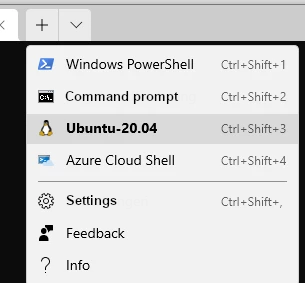
Attention! When the Linux terminal opens, the Windows home directory is displayed and not the Linux distribution home directory.
Therefore, switch to the user's Linux home directory with the following command:
cd ~The installation script can now be copied to the Linux home directory. To do this, enter the following command in the Linux console:
Important: do not forget the dot at the end of the command line)
explorer.exe .This opens the Windows File Explorer in the current directory, which in this case is the user's Linux Home directory. The Linux directory is mounted in Windows like a network drive. Here is an example:
\wsl$\Ubuntu-20.04\home\user
Now use Windows File Explorer to copy the smartWARE_452.2.0.0.12.run installation script to the Linux Home directory \wsl$\Ubuntu-20.04\home\user
Then switch back to the Linux console of the Windows terminal program and start the installation with the following call:
"./" in front of the file name tells Linux to look for the file in the current directory.
chmod +x ./smartWARE_452.2.0.0.12.run
./smartWARE_452.2.0.0.12.runThe installation script now starts and the following output is displayed in the terminal.
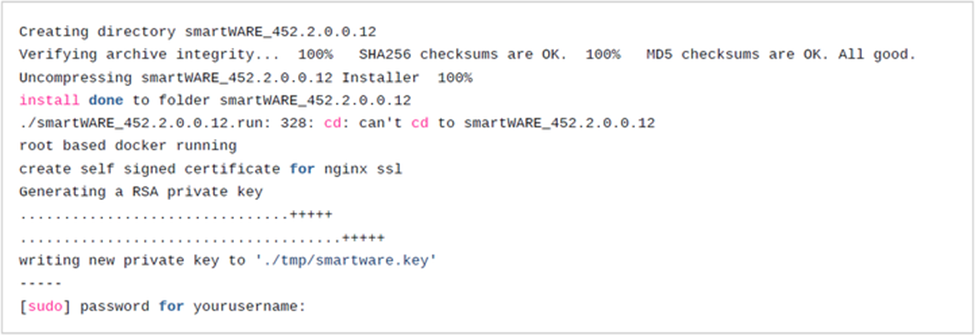
Since root (sudo) privileges are required for the installation, you will be asked for the password. Enter the password you assigned during the WSL Ubuntu installation to complete the installation. To access the application with the Internet browser via HTTPS, the installation script generates a so-called self-signed certificate. This certificate can be replaced later by an official certificate (if available) (see basic configuration).

The script now creates the following new directories:

The directory ~/smartWAREData/ contains all persistent data of the application. This is where all the data that needs to be retained is stored, even after a software update, such as the measured values transferred from the Jupiter devices, user settings such as dashboards or device location information. For this reason, this directory is also specially protected and sudo permissions are required for access. The directory ~/smartWARE_452.2.0.12/ contains all scripts that are needed to run the application. e.g. start and stop script to start and stop the Docker services. In this directory, individual settings can also be configured and saved in a .env file. More about this in the chapter "Basic configuration".
Basic configuration
After executing the installation script, the services can be started. The services are then started with the following default settings.

Each of these default settings can be overwritten and customized. For this purpose, a file with the name .env must be created in the installation directory of the software (~/smartWARE_452.2.0.12). Switch to the directory for the installation in the Linux console:
cd ~/smartWARE_452.2.0.0.12Start the Notepad Editor with the following command:
notepad.exe .envSince the .env file did not previously exist, Notepad asks whether you want to newly create this file.
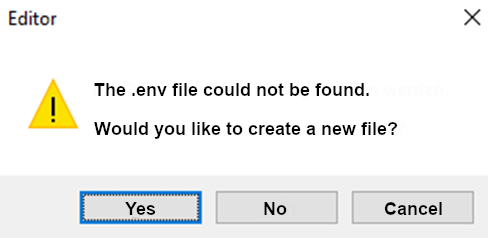
Answer "yes" to this question. Now enter the parameters you want to overwrite in the .env file and save the file. Here is an example of the content in case you need to change the proxy ports, since they may already be used by another application.

Set time zone
The default time zone setting is: DC_TIMEZONE=Europe/Berlin
If the software is operated in another time zone, this setting must be overwritten.
You can find a list of possible time zones here https://en.wikipedia.org/wiki/List_of_tz_database_time_zones
Set up ports
The default setting of the proxy ports is:

This means that the software GUI can be reached via browser using the following URLs:
http://ip
https://ip
It is not necessary to specify the port in this case, because the browsers automatically add port 80 or port 443 for HTTPS, without this being displayed. If the standard ports on the computer to be installed are already in use, the smartWARE Evaluation can be run on any other free ports. To do this, the ports in the .env file must be overwritten. Here is an example:

However, this means that the port must be specified in the browser when accessing the GUI. In this case it would be:
http://ip:8080
https://ip:8443
This changed port must then also be set correctly in the Datastore Gateway of the Jupiter devices! In this case, the port for the HTTP protocol would need to be specified. (Note: The HTTPS protocol in the Jupiter device is only supported as of firmware version 7.x! Installation of the smartWARE Evaluation software on a cloud computer over the Internet should therefore only be considered with the HTTPS support provided by firmware 7.x.)
ip:8080/store (http://ewkssmartware.jumo.net/store)
Replace self-signed certificate
During installation, a self-signed certificate is generated and copied to the directory ~/smartWAREData/reverse_proxy/certs. If you open the software GUI in the browser using the HTTPS protocol, you will get a warning from the browser because the certificate is self-signed. Here is an example for the Chrome browser:
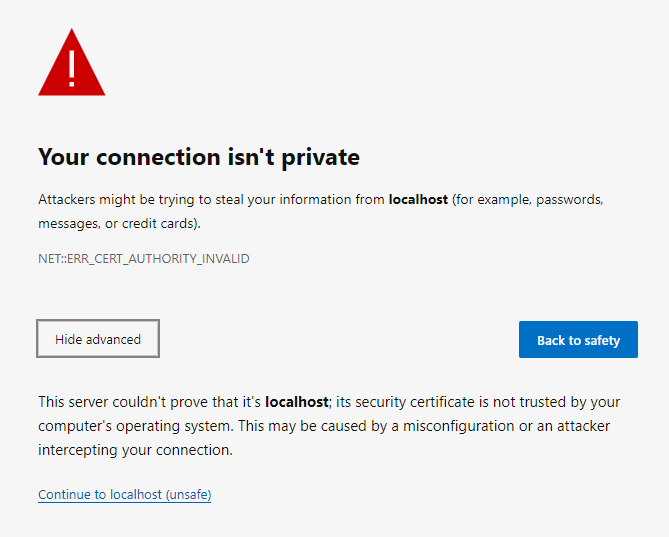
However, you can ignore this warning because the self-signed certificate is not known to the browser. To do this, click the link "continue to... (not secure)". However, you can also prevent the browsers from warning you by using an officially signed certificate or by providing this to the software. There are 2 files in the directory ~/smartWAREData/reverse_proxy/certs
smartware.crt
smartware.key
These files can only be exchanged as root user (sudo). This certificate and key files can be replaced by the company's own officially signed files. To do this, stop the smartWARE services (see 5.2). Rename the two existing files (e.g. to smartware.ctr_original , smartware.key_original). Then copy the officially signed files and rename them if necessary. Important: The files must have the names smartware.crt and smartware.key and must be in PEM/X509 format.
After replacing the files and starting the smartWARE services (see 5.1), please check the log file to ensure that the replaced files do not cause any problems:
$ cat ~/smartWAREData/reverse_proxy/error.log | moreDatastore backup
By default, backup is not enabled because it needs to be configured first. The .env configuration file must be adapted for this purpose:
Parameter | Possible values | Remark |
DC_STORE_BACKUP_FOLDER | Backup directory where the files to be backed up are stored | |
DC_STORE_RESTORE_FOLDER | Restore directory where the files are read for restoration | |
DC_BACKUP_USER_ID | User Id in the Linux system, which is used for the files in the backup directory | |
DC_BACKUP_GROUP_ID | Group Id in the Linux system, which is used for the files in the backup directory |
The recorded data is persistently stored in the following directory.
Here is an example for Ubuntu20.04 and a user "username".
In a Powershell terminal, you can now backup the files with the following command, for example to a fast USB disk (e.g. D:\)
CODE
|
In this case, the files that have not yet been saved on the destination drive are always copied.
Please make sure to replace "username" with the name set on your system, and also change the drive letter of the target drive (in the example D:\ ) to your real system.
robocopy is called according to the following sequence.
robocopy source directory destination directory /MIR the parameter /XF <filename>[ ...] excludes files corresponding to the specified names or pathsthe parameter /XD <directory>[ ...] excludes directories corresponding to the specified names and paths.
This means that the file
\\wsl$\Ubuntu-20.04\home\username\smartWAREData\datastore\database.sqlite3
and the directories
\wsl$\Ubuntu-20.04\home\username\smartWAREData\postgresql
\\wsl$\Ubuntu-20.04\home\username\smartWAREData\reverse_proxy
are not backed up to the destination drive. (This is also not necessary!)
JUMO smartWARE Evaluation backup
By default, backup is not enabled because it needs to be configured first. The .env configuration file must be adapted for this purpose:
Parameter | Possible values | Remark |
DC_VIEW_BACKUP_FOLDER | Backup directory where the files to be backed up are stored | |
DC_BACKUP_USER_ID | User Id in the Linux system, which is used for the files in the backup directory | |
DC_BACKUP_GROUP_ID | Group Id in the Linux system, which is used for the files in the backup directory | |
DC_VIEW_BACKUP_ACTIVE | true false | true activates the data backup |
DC_VIEW_BACKUP_EVERY_DAY_AT | cron entry to define when the backup is to be started, e.g. |
Example of a .env file:
DC_VIEW_BACKUP_FOLDER="~/smartWAREBackup/dataview"
// use the first defined user in the Linux system
DC_BACKUP_USER_ID="1000"
DC_BACKUP_GROUP_ID="1000"
DC_VIEW_BACKUP_ACTIVE="true"
// start data backup every day at 04:00 UTC
DC_VIEW_BACKUP_EVERY_DAY_AT="0 04 * * *"After modifying the .env file, the system must be restarted for the entries to be used.
Set archiving directory and time
By default, archiving is not enabled because it needs to be configured first. The .env configuration file must be adapted for this purpose:
Parameter | Possible values | Remark |
DC_STORE_ARCHIVE_FOLDER | Archiving directory | |
DC_STORE_ARCHIVE_EVERY_DAY_AT | cron entry to define when the | |
DC_STORE_ARCHIVE_TYPE | YEARS, MONTHS, WEEKS, DAYS | Defines which data is to be archived during an archiving run: |
DC_STORE_ARCHIVE_QUANTITY | integer > 0 | see above |
DC_STORE_ARCHIVE_UNLOCK_HOURS | integer > 0 | defines the period in number of hours after which the restored Cold Data will again be automatically deleted. |
Sample file:
DC_STORE_ARCHIVE_FOLDER="~/smartWAREArchive/datastore"
// start archiving every day at 04:00 UTC
DC_STORE_ARCHIVE_EVERY_DAY_AT="0 04 * * *"
// archive all data older than 6 weeks
DC_STORE_ARCHIVE_TYPE=WEEKS
DC_STORE_ARCHIVE_QUANTITY=6
// after 48 hours restored cold data is automatically deleted
DC_STORE_ARCHIVE_UNLOCK_HOURS=48After modifying the .env file, the system must be restarted for the entries to be used.
Activate changes to the .env file
Changes to the .env file only become active when the services are stopped and then restarted. To do this, first start the script ./stop_smartware.sh and then the script ./start_smartware.sh. Then please use the script ./status_smartware.sh to check whether all services started properly. If a service did not start, checking the log or error files of the respective service may help.
Service name | Path for log/error files |
datastore | ~/smartWAREData/datastore/logs |
dataview | ~/smartWAREData/dataview/logs |
reverse-proxy | ~/smartWAREData/reverse_proxy |
In Windows, the log and error files can be selected with the File Explorer and then opened with the Notepad, for example.
To do this, enter the following commands in the Linux console:
$ cd ~/smartWAREData
$ explorer.exe .Updateinstallation
In the following description, as an example, the release version 452.2.0.0.12 is installed/active and an update to version 452.3.0.0.7 is to be performed.
The following steps are necessary for an update installation:
Stopping the old installed version
Copying the new installation script
Make the new installation script executable
Start the new installation script
Copy an .env file, if any, of the old installation to the directory of the new installation.
Start the new version.
Delete the old version.
Stopping the old installed version
Change to the directory of the old version
cd ~ /smartWARE_452 .2.0.0.12/Stopping the old version, by calling the ./stop_smartware.sh script
. /stop_smartware .shCopy the new installation script
Change back to the home directory of the user
cd ~
Copy the new installation script smartWARE_452.3.0.7.run to the user's home directory.
Starting the new installation script
Before the installation script can be started, the file must be made executable.
chmod +x . /smartWARE_452 .3.0.0.7.runStarting the new installation script
. /smartWARE_452 .3.0.0.7.runNow the installation script will start and you will see the following output in the terminal.

The following directory has now been recreated by the script:
~ /smartWARE_452 .3.0.0.7/The directory ~/smartWARE_452.3.0.0.7/ contains all scripts necessary to run the application. E.G.: Start and Stop script to start and stop Docker services respectively. In this directory, individual settings can also be configured and saved in an .env file. More about this under the Basic Configuration chapter.
Copying the old .env file, if available
If an .env file was created for the old installation, this file must now be copied to the newly created directory.
This is important, so that individual adjustments are taken over for the new installation.
cp ~ /smarWARE_452 .2.0.0.12/. env ~ /smartWARE_452 .3.0.0.7/. envStarting the new version
Change to the newly created directory ~/smartWARE_452.3.0.7/ and start the script ./
start_smartware.sh.
cd ~ /smartWARE_452 .3.0.0.7/
. /start_smartware .sh
Delete the old version
The old installation directory ~/smartWARE_452.2.0.12/ and the old installation script ~/smartWARE_452.2.0.12.run can now be deleted.
rm -r ~ /smartWARE_452 .2.0.0.12/
rm ~ /smartWARE_452 .2.0.0.12.runOperation
The smartWARE Evaluation software consists of several individual programs (also referred to as microservices). These programs are started as Docker containers. For easy starting and stopping of the services, in the directory:
~/smartWARE_452.2.0.0.12
there are two Linux shell files
start_smartware.sh
stop_smartware.sh
Starting the services
In the Linux console, switch to the directory ~/smartWARE_452.2.0.0.12 and run the script ./start_smartware.sh:
$ ./start_smartware.shIt is necessary to enter the character combination ./ (i.e. a dot followed by a slash), otherwise Linux will not find the file. It tells Linux that the file is in the current directory.
When you call this script for the first time after installation, the software packages (images) are loaded from the JUMO server first. The individual services are then started as Docker containers. You can view the current status of the services by starting another shell script.
$ ./status_smartware.shYou should now see a list showing you the status of each service:

If all services show the state Up, the services are running. You can now open the start page in the browser by clicking http://IP or https://IP.
Where IP stands for the IPv4 address of the W10 PC on which the services were started. However, you can also use the hostname of the computer instead of the IP address or http://localhost, if the browser was started on the same computer. If ports 80/433 are already being used by another program and you have configured alternate ports through entries in the .env file, please append the respective port to the URL, e.g. http://localhost:8080 or https://localhost:8433.
Stopping the services
To apply changes to the .env files, it is necessary to close each individual service in an orderly fashion before you can restart them. To do this, call the script ./stop_smartware.sh on the Linux console.
$ ./stop_smartware.shIt takes a few seconds for all services to close. The following output is displayed on the screen:

VHDx file
Please always close the smartWARE services as described before making the following changes.
Move
By default, Windows Docker Desktop installs everything on disk C:.
Example: Move the Ubuntu-20.04 VHDx to drive E:.
To move the Ubuntu VHDx file to a second internal, larger SSD, the following steps are required:
As an administrator, open a Windows Powershell and display all distributions:
❯ wsl --list
Windows subsystem for Linux distributions:
Ubuntu-20.04 (Standard)
docker-desktop
docker-desktop-dataMoving the distribution involves the following steps.
The distribution is exported to a .tar file on the SSD E:.
The distribution is logged off.
The exported distribution is imported from the .tar file on the new SSD E:.
After the import has been successfully completed, the .tar file can be deleted.
wsl --export Ubuntu-20.04 E:\ubuntu.tar
wsl --unregister Ubuntu-20.04
Registration is canceled...
wsl --import Ubuntu-20.04 E:\Docker\wsl\Ubuntu-20.04\ E:\ubuntu.tar --version 2This moves the Ubuntu distribution to drive E:\Docker\wsl\Ubuntu-20.04\. To test, open an Ubuntu shell and check. If everything is ok, the file E:\ubuntu.tar can be deleted.
If you want the "root" user to be the default user after starting, do the following:
The default user must be entered in the file /etc/wsl.conf:
[user]
default=enter_my_default_username_here.
Then you need to run "wsl --shutdown" in the Powershell to activate the change.
Increase maximum size
The WSL 2-VHDx uses the Ext4 file system. This VHDx is automatically adjusted to its storage requirements and has an initial maximum size of 256 GB. If the space required by the Linux files exceeds this size, it may be necessary to expand it. If the distribution grows beyond the size of 256 GB, errors are displayed, stating that there is no more storage space available. This error can be fixed by increasing the size of the VHDx, provided that the physical disk is also large enough. The following example refers to an Ubuntu distribution vhdx that was already moved to another drive (E:)! In this case the size is increased from 256GB to 356GB.
maximum=356000
Open a Powershell:
PS C:\WINDOWS\system32> wsl --shutdown
PS C:\WINDOWS\system32> diskpart
Microsoft DiskPart-Version 10.0.19041.610
Copyright (C) Microsoft Corporation.
On computer: EW-TEST
DISKPART> Select vdisk file="E:\Docker\wsl\Ubuntu-20.04\ext4.vhdx"
The file for virtual data media was successfully selected by DiskPart.
DISKPART> detail vdisk
Device type ID: 0 (unknown)
Manufacturer ID: {00000000-0000-0000-0000-000000000000} (unknown)
Status: Added
Virtual size: 256 GB
Physical size: 27 GB
File name: E:\Docker\wsl\Ubuntu-20.04\ext4.vhdx
Is subordinate: No
Higher-level file name:
Assigned data medium number: Not found.
DISKPART> expand vdisk maximum=356000
100 percent processed
The file for virtual data media was successfully expanded by DiskPart.
DISKPART> exitNow start the Ubuntu distribution and switch to the Linux shell:
df -h
Filesystem Size Used Avail Use% Mounted on
/dev/sdb 251G 28G 211G 12% /
tmpfs 3.1G 0 3.1G 0% /mnt/wsl
tools 454G 273G 182G 61% /init
none 3.1G 0 3.1G 0% /dev
none 3.1G 4.0K 3.1G 1% /run
none 3.1G 0 3.1G 0% /run/lock
none 3.1G 0 3.1G 0% /run/shm
none 3.1G 0 3.1G 0% /run/user
tmpfs 3.1G 0 3.1G 0% /sys/fs/cgroup
C:\ 454G 273G 182G 61% /mnt/c
E:\ 466G 109G 358G 24% /mnt/e
sudo resize2fs /dev/sdb 356000M
[sudo] password for user:
resize2fs 1.45.5 (07-Jan-2020)
Filesystem at /dev/sdb is mounted on /; on-line resizing required
old_desc_blocks = 32, new_desc_blocks = 44
The filesystem on /dev/sdb is now 91136000 (4k) blocks long.
df -h
Filesystem Size Used Avail Use% Mounted on
/dev/sdb 342G 28G 298G 9% /
tmpfs 3.1G 0 3.1G 0% /mnt/wsl
tools 454G 273G 182G 61% /init
none 3.1G 0 3.1G 0% /dev
none 3.1G 8.0K 3.1G 1% /run
none 3.1G 0 3.1G 0% /run/lock
none 3.1G 0 3.1G 0% /run/shm
none 3.1G 0 3.1G 0% /run/user
tmpfs 3.1G 0 3.1G 0% /sys/fs/cgroup
C:\ 454G 273G 182G 61% /mnt/c
E:\ 466G 109G 358G 24% /mnt/eBackground information
Explanation of terms
Docker: Stores programs and their dependencies in images. These form the basis for virtualized containers that can run on almost any operating system. This makes applications portable and uncomplicated.
Docker Desktop: Docker Desktop is an easy-to-install application for a Windows environment that can be used to build and share containerized applications and microservices. Docker Desktop includes Docker Engine, Docker CLI client, Docker Compose, Docker Content Trust, Kubernetes and Credential Helper.
Docker Compose: Docker Compose is a tool designed to define and enable multicontainer applications. Compose can be used to define services, which can then be started or stopped with a single command.
Docker Image: You may be familiar with the term "image" in the context of virtualization in relation to virtual machines (VMs). Typically, a VM image is a copy of an operating system. If necessary, a VM image contains other installed components such as database and web server. The term comes from a time when software was distributed on optical media such as CD-ROMs and DVDs. If a local copy of the data medium was required, special software was used to create an image. Container virtualization is the logical next step in the development of VM virtualization. Instead of virtualizing a virtual computer (machine) with its own operating system, a Docker image typically includes only one application. This can be a single binary file or a composite of several software components.
Docker Container: Over the last decade, the Docker virtualization solution has fundamentally changed how software is built, distributed and operated. Unlike the previously established virtual machines (VM), Docker virtualizes individual applications. A Docker container, therefore, is an application or software container. The term software container is adapted from physical containers such as those used on ships. In logistics, containers as standardized units made modern retail chains possible in the beginning. Thus, a container can be transported on any ship, truck or train designed for this purpose. This operates almost independently of the contents of the container. On the outside, the container is equipped with standardized interfaces. This is quite similar to the situation with Docker containers.
VHDx file: In a VHDx file, the contents of a complete hard disk can be stored virtually in the form of a single file. The file format is an extension of the VHD format and was first released with Windows 8 and Windows Server 2012. It offers numerous improvements and functional enhancements compared to the VHD format.
Software structure
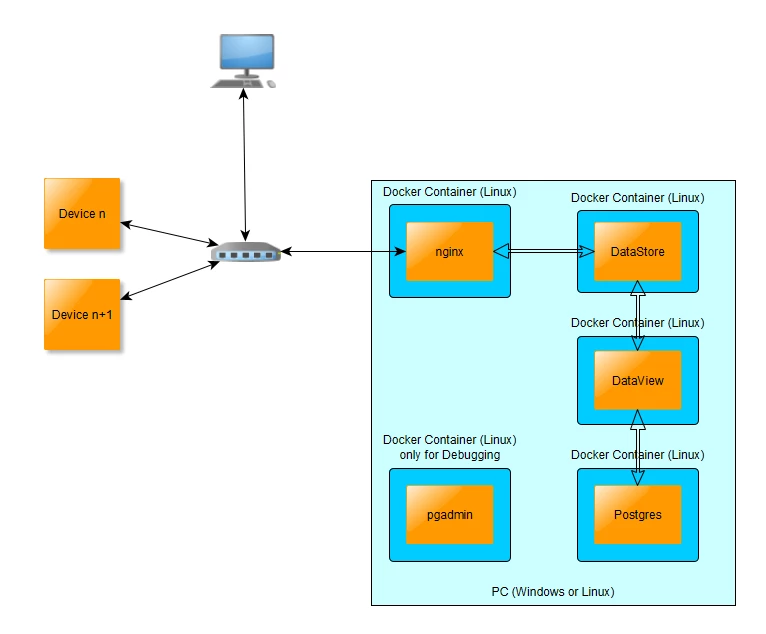
The smartWARE Evaluation software consists essentially of 4 functional units (services):
Datastore
Stores the original data (Cold Data) sent by the Jupiter devices at intervals.Dataview
Prepares parts of the data (Cold Data) and stores them in the Postgres database (Warm Data). Receives user input from the browser application and provides the data to display the dashboard graphs/tables.Postgres database
This is where the so-called Warm Data is stored, i.e. the portion of the data that is used for quick display in the dashboards.Nginx (Reverse Proxy)
The http(s) interface of the services.
These services are developed as Linux Docker containers and are configured and started/stopped using Docker Compose. The data is displayed to the user via a web browser on any computer in the network.
Persistent data
All recorded data is persistently stored by the Datastore service in the Linux user's home directory:
~/smartWAREData/datastore
The data is stored in packed files, and protected from tampering by additional signed files. This entire data set is also referred to as Cold Data.
Deleting this directory or individual files from this directory will result in the loss of the recorded data unless a copy of the data was made!
Automate backup
To avoid always having to start robocopy manually, you can also automate the process on a daily basis using Windows Task Scheduler.
To do this, open the "Task Scheduler" program.
In the "Actions" section, click "Create simple task..."..
A wizard opens, in which you need to enter a name and a description:
Then click the button "Next >".
For example, select "Daily" and then click "Next >".
In this dialog, select the date and time when the backup is to start for the first time and then click "Next >".
If "Start program" was selected, click "Next >".
In the field "Programs/Script", please enter "robocopy" and in the field "Add arguments (optional)", enter the following long parameter text, which of course needs to be changed to your user name and the correct destination drive letter:
CODE
|
Then click "Next >".
Click "Finish".
You can now also start the task directly to check that the data is also copied to the destination drive.
